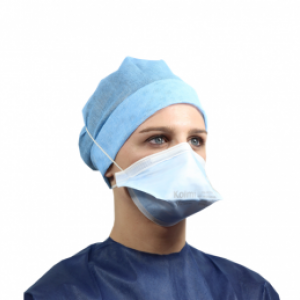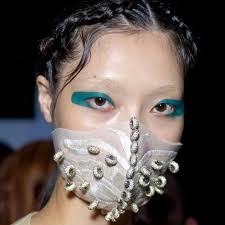ALL ABOUT MASKS AND CORONAVIRUS
Dr N Raboobee FFDerm(SA)

Prior to the Covid-19 pandemic, as dermatologists, we wore only one kind of mask - the surgical mask that covered our faces and hooked around our ears. Those were easy days.
Then came along Corona virus and we were all of a sudden exposed to a plethora of masks, with much confusion and controversy surrounding them. We heard about the N95 mask, the Surgical Mask and the FFP2,3,4, KN95 and KF94 masks.
Governments were unclear about whether to recommend the wearing of masks to the general public and then too which type of mask to recommend - Also there was confusion about whether the mask protects the wearer or just the people the wearer comes into contact with. With the global shortage of masks, prices began skyrocketing and were often not even available for purchase. Home made masks began making their appearance.
First, just a little about mask nomeclature. The N, K or FFP refers to the certification authority and the country of origin. N masks are certified in the USA, FFP in the European Union, KN in China and KF in Korea. The numbers following the letters refer to the filtration efficiency.
N95 mask
So, starting with the N95 mask, the full name is NIOSH-certified N95 respirator, meaning that the mask is certified by the National Institute of Occupational Safety and Health in the USA to have a filtration efficiency of 95%. The N95 mask is designed to reduce the users exposure to airborne particles as small as 0.3microns as well as large droplets. A cushioned metal strip above the nose allows for a custom fit and a secure seal, minimising leakage. A duck bill shape is also available. Under normal circumstances, the N95 mask is regarded as a reusable mask and can be used for 2 days to a week depending on its condition. Naturally different rules apply under Covid-19.
The Surgical Mask

The surgical mask was designed to prevent contamination of the surgical field or the patient by the user. It is fluid resistant and protects the user against larger particles (>5microns), droplets, sprays and splatter. They are meant for single use and disposable. However, during the time of severe mask shortages, they are often kept on for the whole day. If it protects others from the users droplets, it stands to reason that if everyone wears such a mask, then all would be protected.
Masks with exhalation valves

Masks are also available with exhalation valves. Such masks are not recommended for Covid-19 as they allow the user to breathe out particles through the one way valve and transfer any virus in the process. The purpose of the valve is to prevent the wearer’s spectacles from fogging up.
What about home made masks?

The messages regarding wearing of masks are confusing to say the least. Governments are not even in agreement. Until recently the Western Cape Health Department was advising against it and even went so far as to say that it can promote spread of the virus. Woolworths had notices up to discourage the wearing of masks. Pick n Pay had this to say: “The World Health Organisation (WHO) clearly advises that a healthy person should only wear a face mask if they are taking care of someone suspected of having coronavirus, or if they are coughing themselves”.
In support of wearing of masks is this study performed during a flu epidemic in 2013 looking at 21 volunteers who made their own face masks from cotton t-shirts. The number of micro-organisms isolated from coughs of these volunteers were compared with those wearing surgical masks, home made masks and no masks. Both masks significantly reduced the amount of microorganisms expelled by volunteers but surgical masks were found to be 3 times more efficient than home made masks. The conclusion of the authors was that homemade masks should be used as a last resort to prevent droplet transmission from infected individuals but is better than no protection.
I would like to add that the tightness of the weave and the number of layers of the fabric used may have some influence on the transmission. Also the size of mask and how effectively it covers both the nose and mouth may also affect the protection offered.
The following graphs presented by #Masks4All analysed by Johns Hopkins University shows clearly the reduction in transmission in mask wearing societies.
The recent finding that Cornovirus may be airborne adds credence to the idea of face maskusage.
The US Centre for Disease Control says that a cloth mask does not protect you from getting Corona virus but prevents you from spreading the virus to others. So although the mask mainly helps others, if used properly, cloth masks may help avoid touching the face with your hands and getting infected. Also if everyone is wearing a mask, while you are protecting others, others are protecting you.
I am in agreement that medical masks should be reserved for medical personnel (at least during the shortage) and that the public should wear some kind of face and nose cover. A home made mask is better than no mask at all, especially in the age of shortage of surgical masks so widely worn in the east.
I can foresee designer masks making their appearance in the near future, even coordinated with suits and dresses, and will soon become status symbols
What will I be doing?
I will be wearing an N95 mask when examining patients and performing procedures and switch to a surgical mask (much easier to breathe) when talking from across my desk, using a face shield with each one. My staff will wear cloth masks and face shields. The cloth masks will be washed daily and the face shields will be cleaned regularly with alcohol. When the shortage of surgical masks ends, the staff will be issued with surgical masks. The measures outlined are designed to provide the best protection possible to all parties concerned. New information is emerging every day so we’ll also watch this space.

Recent update
The SA government has recently issued an update regarding the wearing of masks. Cloth masks have been advised for the public. These can be washed for 5min in boiling water and ironed before wearing. The masks are not to be removed when speaking or coughing and should cover 50% of the nose and should reach 25mm under the chin. The fabric should have a tight weave and should be water resistant.
Our advice:
Please do not leave home without your mask, for your protection and for the protection of those around you.
If you are in close contact with people, consider wearing a face shield in addition.
Practice all the basic protective measures that we are hearing about all the time:
Wash your hand frequently with soap and water or
Use alcohol based sanitisers
Maintain social distancing
Avoid touching eyes, nose and mouth
Cover your mouth and nose with your bent elbow when you cough or sneeze or use a tissue and discard immediately.
If you have a cough, fever and difficulty in breathing, seek medical care early.
Further reading:
Can Face Masks Protect You from the 2019 Coronavirus? What Types, When and How to Use
On a lighter note: Strange masks from around the world











Comments